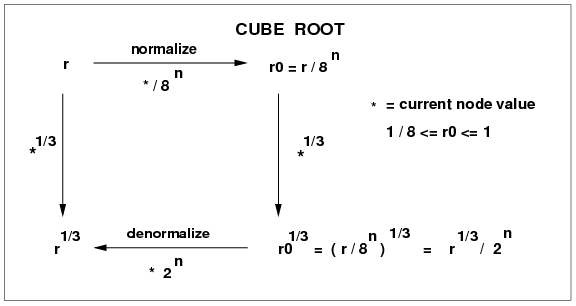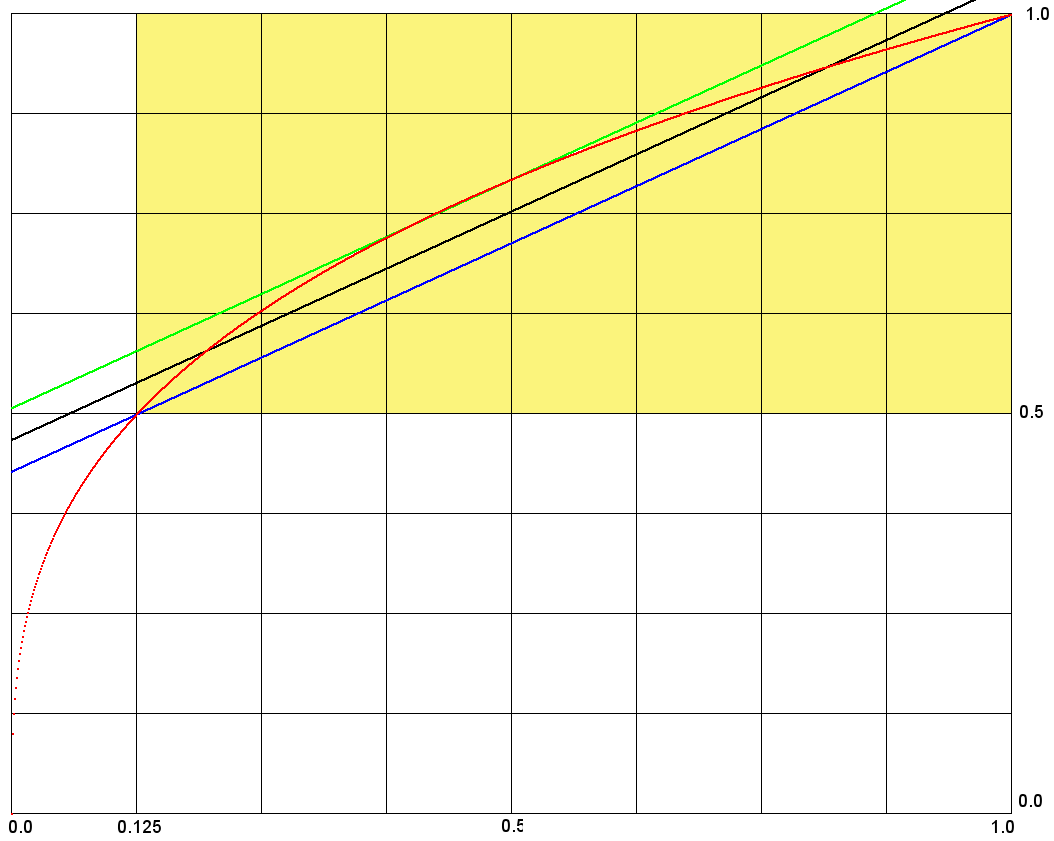|
CS 3343/3341 Analysis of Algorithms Numerical Calculations Normalize & Denormalize |
Normalize / Denormalize: This refers to a common process during numerical computations, where one shrinks the allowed input to a standard interval, and extends a solution for such an interval to a solution for all inputs. In each of the cases here one ends up with a square diagram of four functions, where the two ways of following arrows through the diagram yield the same result. Such diagrams are called commutative.
[Normalization is most frequently encountered by beginning CS students when they study the IEEE floating representation of real numbers. These are represented by base 2 scientific notation in the form:Here are three examples on separate pages:
(+|−)1.xxxxxx...2×2yyyy..., where the x's and y's are binary bits.
One bit for the sign, 11 bits for the exponent (the y's) and 52 bits for the significant bits (the x's). To convert a positive number x, say 1/3 to IEEE form, first multiply by a power of 2 so that the number x' satisfies 1 < x' < 2. So x = 1/3 = 4/3 × 2-2. Then 4/3 in binary is 1.01010101...2. The 01010101... are the x's above, and the -2 is encoded as the y's. See doubles.
This example is similar to the Division example below.]
- square root,
- division or reciprocal, and
- log base 2, plus: more explanation.
- Cube root,
- f(x) = 2x
Cube root: Here is another example, presented as the four problems 1 through 4 below, with some comments in red after problems:
- Mimic what we did for square root to find the
cube root. We start with r > 0.
We want r1/3. We will normalize
into the interval [1/8,1] by dividing by
8n for suitable n.
Do up the square diagram, with r, r0=r/8n,
r01/3, and r1/3 in the
four corners (clockwise). Finish up all the other
details about the diagram, following the pattern for
square root.

Click box or here for full size image.
- Continuing the problem above, show how to use Newton's Method
to find r1/3.
Use the function
f(x) = r - x3.
You need to know that
f ' (x) = - 3 * x2.
Don't write any code, but just produce the Newton's
iteration formula. If r=27 and x0=2.9,
calculate by hand the next approximation x1.
[ x1 = x0 - f(x0) / f ' (x0)
= x0 - (r - x03) / (-3*x02)
= x0 + (r - x03) / (3*x02)
= x0 + r / (3*x02) - x03 / (3*x02)
= (2/3)*x0 + r / (3*x02) =
= (2/3)*2.9 + 27 / (3*(2.9)2) =
= 1.9333333333 + 27 / 25.23 = 3.0034879#include <stdio.h> int main() { double x0=2.9, x1, r=27; int i; for (i = 0; i < 10; i++) { x1 = (2./3.)*x0 + r / (3.*x0*x0); printf("i:%2i, r: %.4f, x1: %.16f\n", i, r, x1); x0 = x1; } } i: 0, r: 27.0000, x1: 3.0034879112168054 i: 1, r: 27.0000, x1: 3.0000040488977464 i: 2, r: 27.0000, x1: 3.0000000000054645 i: 3, r: 27.0000, x1: 3.0000000000000000
Calculate the function f(x) = 2x: Here is a final example, the inverse of log base 2: For this question we want to calculate a function as we did with square root, reciprocal, and log base 2. This time the function is f(x) = 2x, that is, 2 to the power x. This problem is only concerned with the normalization and denormalization. Separately, we would use a series to calculate 2x for 0 <= x <= 1, but that isn't part of this problem. You are to draw the square diagram similar to the ones we had in the other 3 examples. Remember that we are implementing the function 2x. Start with x in the upper left corner. Then the "normalized" value x0 is found by taking floor(x) and subtracting it from x. (Here floor(x) is the largest integer value less than or equal to x.) For example, if x = 7.3, then x0 = 0.3, and if x = -5.6, then x0 = 0.4.
- Explain the the second example above:
if x = -5.6, why is x0 = 0.4?
[ floor(-5.6) = -6, so x - floor(x) = -5.6 - (-6) = -5.6 + 6 = 0.4 ] - Carefully fill
in the rest of the diagram, using variables, rather than
specific numbers. (One key step is determining the
denormalization formula.)
x = input double, m = floor(x) * = node value * - m x --------------------> x0 = x - m | | | | | | | | * | | * 2 | | 2 | | | | | | V V x x0 (x - m) x / m 2 <--------------------- 2 = 2 = 2 / 2 m * (times) 2 - Trace through the diagram using
the initial value x=6.5, and carrying specific
numbers all the way through the diagram. (Remember that a positive
number to the 0.5 power is just the square root of
the number.)
6.5 = input double, 6 = floor(6.5) * = node value * - 6 6.5 --------------------> 0.5 = 6.5 - 6 | | | | | | | | * | | * 2 | | 2 | | | | | | V V 6.5 0.5 (6.5 - 6) 6.5 / 6 2 <---------------------- 2 = 2 = 2 / 2 6 * (times) 2 Here 26.5 is computed by normalizing 6.5 to 0.5, calculating 20.5, and denormalizing by multiplying by 26 = 64. Thus 26.5 = 20.5 (times) 26. We would use a series to calculate 20.5, and just as before, we only need to calculate 2x for 0 <= x <= 1. For very large x or for negative x with large absolute value, the series wouldn't work, so this normalization is necessary. Finally, we would get 20.5 = 1.41421356 (using the series), and 26.5 = 1.41421356 * 64 = 90.50966799 (using the normalization/denormalization). (In at least some places, this is the way 2x is actually calculated.)

